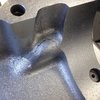Usually I avoid blasting crankcases and cylinder heads due to the fear of leaving the odd particle or two of blasting media inside the engine. I have heard of horror stories of engines been destroyed in only a few miles and so I have always cleaned such items with solvents etc and never had a problem.
However I'm currently working on a early series B engine that has been stood in a shed for 50 years and is quite corroded etc and needs more than just a solvent clean. See photo attached of what I am starting with. This engine has being nicknamed "The hairy B".
Options are vaqua /vapour (wet) blasting which gives a nice sheen to the alloy which looks as cast and also appears to seal the casting pores, and I have seen crankcases blasted this way still look good even after heavy use years later. Disadvantage is every last bead needs getting rid off after and the worry is some could be left lurking in the corner of an oilway etc.
Another option is soda blasting which has the advantage of being water soluble so its easier to eliminate the media after blasting but I don't know what the finished result looks like and even if it will remove aluminium oxide corrosion. Could anybody who had had crankcases or cylinder heads soda blasted post photo here showing the end result and their experience. Is is a matt finish or a slight sheen to it like vapour blasting? Also what do they look like several years later, ie is the surface pores sealed like wet vapor blasting?
I have read the various posts on the forum already about soda blasting but cannot find comments as to the finished look.
Thanks
Simon




